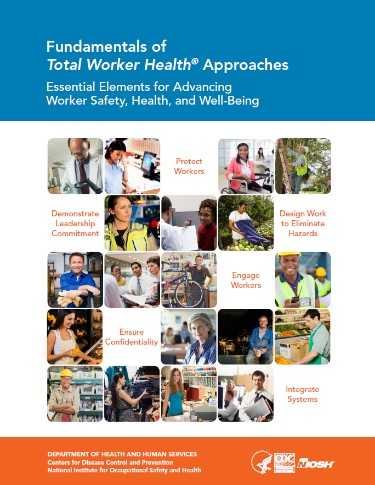NIOSH Releases Guidance for Implementing Total Worker Health® in the Workplace
December 21, 2016
NIOSH Update:
Contact: : Nura Sadeghpour (202) 245-0673
The National Institute for Occupational Safety and Health (NIOSH) and its Total Worker Health (TWH) program released a workbook this month that provides a practical starting point for employers, workers, and other professionals to implement workplace safety and health programs and identify initial steps to improve worker well-being. The workbook can help organizations identify and address job-related factors that may be contributing to health problems, like hours of work, workload and stress levels, interactions with coworkers, and unhealthful work environments.
NIOSH defines Total Worker Health as policies, programs, and practices that integrate protection from work-related safety and health hazards with promotion of injury and illness prevention efforts to advance worker well-being.
The workbook, Fundamentals of Total Worker Health® Approaches: Essential Elements for Advancing Worker Safety, Health, and Well-being, prioritizes a hazard-free work environment for all workers and applies a modern prevention approach—consistent with traditional occupational safety and health prevention principles—that recognizes that job-related factors can have an important impact on the well-being of workers, their families, and their communities.
“Integrated interventions that collectively address worker safety, health and well-being help to align with the recognition that work influences overall health,” said NIOSH Director John Howard, M.D. “The Total Worker Health philosophy advocates for the integration of occupational safety and health protection in the workplace, advancing overall worker health and well-being through the elimination or control of workplace hazards.”
The workbook introduces five Defining Elements of TWH:
- Demonstrate leadership commitment to worker safety and health at all levels of the organization.
- Design work to eliminate or reduce safety and health hazards and promote worker well-being.
- Promote and support worker engagement throughout program design and implementation.
- Ensure confidentiality and privacy of workers.
- Integrate relevant systems to advance worker well-being.
In addition to providing examples of TWH approaches, a self-assessment tool, and resources to develop an action plan and measure progress specific to the organization, the workbook features a new conceptual model, the Hierarchy of Controls Applied to NIOSH Total Worker Health.® A hierarchy of controls is a system that lists how to minimize or eliminate exposure to hazards in the workplace, from what is most effective to what is least effective. This expanded new model serves to illustrate how Total Worker Health approaches emphasize organizational-level interventions to protect workers’ safety, health, and well-being.
In 2017, NIOSH intends to gather feedback from organizations, practitioners, and others who pilot this workbook.
For more information about Total Worker Health visit: http://www.cdc.gov/niosh/TWH/. Total Worker Health® is a registered trademark of the U.S. Department of Health and Human Services.
NIOSH is the federal institute that conducts research and makes recommendations for preventing work-related injuries, illnesses, and deaths. For more information about NIOSH visit www.cdc.gov/niosh/.
- Page last reviewed: April 28, 2016
- Page last updated: December 21, 2016
- Content source:
- National Institute for Occupational Safety and Health Education and Information Division


 ShareCompartir
ShareCompartir
